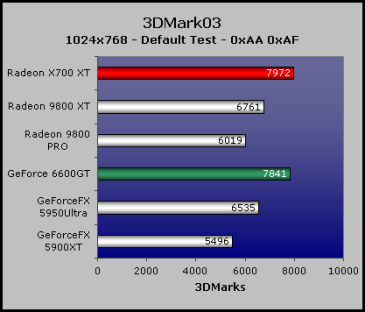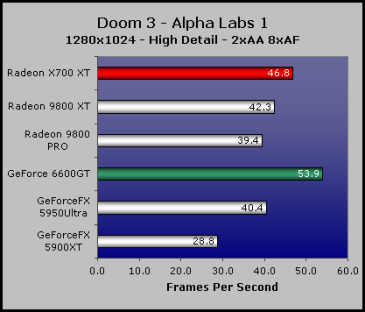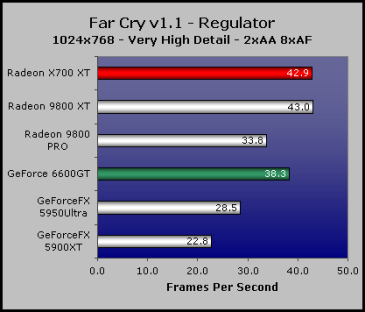3DMark 03
Publisher: Futuremark

It may seem unusual for you to see 3DMark03 included in our testing suite again, but for reference purposes it proves to be a good performance indication. However, as you will see from the results over the course of this review, 3DMark performance isn't everything. Both NVIDIA and ATI suggested that their new mainstream boards would score around 8,000 3DMarks. On our 3.2GHz test system, they score a little bit below the claimed score - at 3.6GHz, 8,000 3DMarks is most definitely within reach.
Performance over both the NVIDIA graphics board range and the ATI graphics board range increases in a fairly linear fashion - the GeForceFX 5900XT is the slowest board in this test, and the Radeon X700 XT is the fastest. The superior memory bandwidth of the X700 XT would appear to give it the performance edge over the GeForce 6600GT, which has a higher fill-rate. The 9800 series lacks the texture & pixel fill-rate required to keep level with the X700 XT. What is very interesting is the fact that the X700 XT performs so much better than the 9800 XT when the core clocks are less than 60MHz apart, while the 9800 XT has a far superior peak memory bandwidth - this is thanks to the more expensive 256 bit memory interface.
Doom 3
Publisher: Activision

Since the release of Doom 3, ATI have been lagging behind in this title by a considerable margin. The GeForce 6600GT has proven to give ATI yet another headache in this title - the way that the engine handles the lighting and shader effects is to NVIDIA's benefit, as the NV4x series of GPU's was designed with Doom 3 performance right at the top of the list. Even with Catalyst AI calculating the pixel and texture shaders on the fly, the GeForce 6600GT still has a huge performance lead in this title. We really don't see this situation changing any time soon. Apart from the GeForce 6600GT, the Catalyst AI calculation method proves to work - it has raised the performance of both the 9800 PRO and 9800 XT up to a level that is very competitive with the GeForceFX 5950Ultra.
Far Cry v1.1
Publisher: Ubisoft

Far Cry has not been one of NVIDIA's strengths due to the fact that the NV3x path was considerably slower than the R300 code path. The Radeon X700 XT makes use of the R300 path, and performs well at the test resolution. The extra 128MB frame buffer on the Connect3D Radeon 9800 XT proves to help performance in this title - the frame rate that the 9800 XT returned is the same as the X700 XT at the test resolution. We can expect that the 9800 XT will outperform the X700 XT with more Anti-Aliasing, due to the fact that the 9800 XT has both a larger frame buffer, and also a higher peak memory bandwidth.
The situation is likely change when Shader Model 2.0b and 3Dc are implemented in to the Far Cry engine - we can expect the X700 XT's performance to increase further, which should mean that it would outperform the 9800 XT at resolutions that do not saturate the frame buffer. Taking the slower chipset on the AGP system in to account would mean that the 9800 XT is possibly ahead by a few percent, but we expect that this performance difference will be negligible.
The GeForce 6600GT is using the NV4x path, which is slightly faster than the NV3x path; however, we're not likely to see the 6600GT competing with the X700 XT until Shader Model 3.0 is available again. It was briefly available in version 1.2, but Crytek pulled the patch because of a performance issue with some, but not all ATI boards.
Publisher: Futuremark

It may seem unusual for you to see 3DMark03 included in our testing suite again, but for reference purposes it proves to be a good performance indication. However, as you will see from the results over the course of this review, 3DMark performance isn't everything. Both NVIDIA and ATI suggested that their new mainstream boards would score around 8,000 3DMarks. On our 3.2GHz test system, they score a little bit below the claimed score - at 3.6GHz, 8,000 3DMarks is most definitely within reach.
Performance over both the NVIDIA graphics board range and the ATI graphics board range increases in a fairly linear fashion - the GeForceFX 5900XT is the slowest board in this test, and the Radeon X700 XT is the fastest. The superior memory bandwidth of the X700 XT would appear to give it the performance edge over the GeForce 6600GT, which has a higher fill-rate. The 9800 series lacks the texture & pixel fill-rate required to keep level with the X700 XT. What is very interesting is the fact that the X700 XT performs so much better than the 9800 XT when the core clocks are less than 60MHz apart, while the 9800 XT has a far superior peak memory bandwidth - this is thanks to the more expensive 256 bit memory interface.
Doom 3
Publisher: Activision

Since the release of Doom 3, ATI have been lagging behind in this title by a considerable margin. The GeForce 6600GT has proven to give ATI yet another headache in this title - the way that the engine handles the lighting and shader effects is to NVIDIA's benefit, as the NV4x series of GPU's was designed with Doom 3 performance right at the top of the list. Even with Catalyst AI calculating the pixel and texture shaders on the fly, the GeForce 6600GT still has a huge performance lead in this title. We really don't see this situation changing any time soon. Apart from the GeForce 6600GT, the Catalyst AI calculation method proves to work - it has raised the performance of both the 9800 PRO and 9800 XT up to a level that is very competitive with the GeForceFX 5950Ultra.
Far Cry v1.1
Publisher: Ubisoft

Far Cry has not been one of NVIDIA's strengths due to the fact that the NV3x path was considerably slower than the R300 code path. The Radeon X700 XT makes use of the R300 path, and performs well at the test resolution. The extra 128MB frame buffer on the Connect3D Radeon 9800 XT proves to help performance in this title - the frame rate that the 9800 XT returned is the same as the X700 XT at the test resolution. We can expect that the 9800 XT will outperform the X700 XT with more Anti-Aliasing, due to the fact that the 9800 XT has both a larger frame buffer, and also a higher peak memory bandwidth.
The situation is likely change when Shader Model 2.0b and 3Dc are implemented in to the Far Cry engine - we can expect the X700 XT's performance to increase further, which should mean that it would outperform the 9800 XT at resolutions that do not saturate the frame buffer. Taking the slower chipset on the AGP system in to account would mean that the 9800 XT is possibly ahead by a few percent, but we expect that this performance difference will be negligible.
The GeForce 6600GT is using the NV4x path, which is slightly faster than the NV3x path; however, we're not likely to see the 6600GT competing with the X700 XT until Shader Model 3.0 is available again. It was briefly available in version 1.2, but Crytek pulled the patch because of a performance issue with some, but not all ATI boards.

MSI MPG Velox 100R Chassis Review
October 14 2021 | 15:04






Want to comment? Please log in.